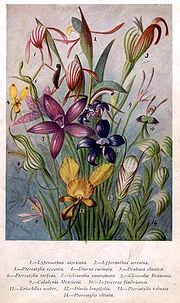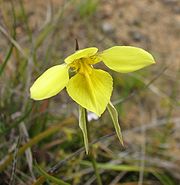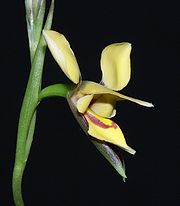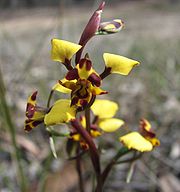
Diuris
Encyclopedia
Diuris is a genus
of herbaceous plant belonging to the orchid family (Orchidaceae
), with more than fifty described species. The genus is presently being revised, with many newly described species.
The scientific name is derived from the Greek words dis (double) and oura (tail), referring to the two lateral drooping sepals, giving a tailed appearance. The common name Donkey Orchid is logically derived from the appearance of the two lateral petals, protruding from the top of the flower like the two ears of a donkey. These features give Diuris its easily recognizable appearance.
Diuris consists of perennial species native to open habitat
s in Australia
and Tasmania
, with the exception of one species endemic to Timor
.
Many species are common in Australia. They grow in large clusters, due to the vegetative growth of their tubers. The genus is one of the best known of Australian terrestrial orchids with the purple Diuris (D. punctata) being always popular when exhibited.
The basal, grass-like leaves
are medium-sized to large. They grow alternately or whorled. Their margins are entire. The central stem
can grow up to 1 m high.
During summer, these terrestrial orchids shrivel and wither above the ground. Their underground tubers then become dormant.
The hermaphroditic flower
s grow solitary or in several-flowered loose racemes. They can be most diverse, from small (1 cmà to large (6 cm), fragrant or not. Their 3-merous form is usually very irregular. The flowers may be blotched or lacking spots. Their colors vary from a lemon yellow, or yellow and brown, yellow and purple, yellow and orange, to pink and white, or purple. The two lateral petal
s are rounded or elongated. The dorsal petal forms a hood over the column
. The lip
is three-lobed. The two lateral lobes form wings.
The flowering period is between July and November.
Pollination is by native, small bee
s, lured to flowers mimicking flowers of the pea family (Fabaceae
), but syrphiid flies and beetles may pollinate as well. The fruit
is a non-fleshy, dehiscent capsule
, containing between 30 and 500 minute seed
s. These seeds mature in a matter of weeks.
Diuris can be grown in a free draining mixture and are relatively easily grown from seed using in-vitro techniques.
The orchids of Diuris are susceptible to the Diuris virus Y, a positive stranded ssRNA virus
from the family Potyviridae





Furthermore there are several species discovered but not named yet.
Genus
In biology, a genus is a low-level taxonomic rank used in the biological classification of living and fossil organisms, which is an example of definition by genus and differentia...
of herbaceous plant belonging to the orchid family (Orchidaceae
Orchidaceae
The Orchidaceae, commonly referred to as the orchid family, is a morphologically diverse and widespread family of monocots in the order Asparagales. Along with the Asteraceae, it is one of the two largest families of flowering plants, with between 21,950 and 26,049 currently accepted species,...
), with more than fifty described species. The genus is presently being revised, with many newly described species.
The scientific name is derived from the Greek words dis (double) and oura (tail), referring to the two lateral drooping sepals, giving a tailed appearance. The common name Donkey Orchid is logically derived from the appearance of the two lateral petals, protruding from the top of the flower like the two ears of a donkey. These features give Diuris its easily recognizable appearance.
Diuris consists of perennial species native to open habitat
Habitat (ecology)
A habitat is an ecological or environmental area that is inhabited by a particular species of animal, plant or other type of organism...
s in Australia
Australia
Australia , officially the Commonwealth of Australia, is a country in the Southern Hemisphere comprising the mainland of the Australian continent, the island of Tasmania, and numerous smaller islands in the Indian and Pacific Oceans. It is the world's sixth-largest country by total area...
and Tasmania
Tasmania
Tasmania is an Australian island and state. It is south of the continent, separated by Bass Strait. The state includes the island of Tasmania—the 26th largest island in the world—and the surrounding islands. The state has a population of 507,626 , of whom almost half reside in the greater Hobart...
, with the exception of one species endemic to Timor
Timor
Timor is an island at the southern end of Maritime Southeast Asia, north of the Timor Sea. It is divided between the independent state of East Timor, and West Timor, belonging to the Indonesian province of East Nusa Tenggara. The island's surface is 30,777 square kilometres...
.
Many species are common in Australia. They grow in large clusters, due to the vegetative growth of their tubers. The genus is one of the best known of Australian terrestrial orchids with the purple Diuris (D. punctata) being always popular when exhibited.
The basal, grass-like leaves
Leaf
A leaf is an organ of a vascular plant, as defined in botanical terms, and in particular in plant morphology. Foliage is a mass noun that refers to leaves as a feature of plants....
are medium-sized to large. They grow alternately or whorled. Their margins are entire. The central stem
Plant stem
A stem is one of two main structural axes of a vascular plant. The stem is normally divided into nodes and internodes, the nodes hold buds which grow into one or more leaves, inflorescence , conifer cones, roots, other stems etc. The internodes distance one node from another...
can grow up to 1 m high.
During summer, these terrestrial orchids shrivel and wither above the ground. Their underground tubers then become dormant.
The hermaphroditic flower
Flower
A flower, sometimes known as a bloom or blossom, is the reproductive structure found in flowering plants . The biological function of a flower is to effect reproduction, usually by providing a mechanism for the union of sperm with eggs...
s grow solitary or in several-flowered loose racemes. They can be most diverse, from small (1 cmà to large (6 cm), fragrant or not. Their 3-merous form is usually very irregular. The flowers may be blotched or lacking spots. Their colors vary from a lemon yellow, or yellow and brown, yellow and purple, yellow and orange, to pink and white, or purple. The two lateral petal
Petal
Petals are modified leaves that surround the reproductive parts of flowers. They often are brightly colored or unusually shaped to attract pollinators. Together, all of the petals of a flower are called a corolla. Petals are usually accompanied by another set of special leaves called sepals lying...
s are rounded or elongated. The dorsal petal forms a hood over the column
Column (botany)
The column, or technically the gynostemium, is a reproductive structure that can be found in several plant families: Aristolochiaceae, Orchidaceae, and Stylidiaceae....
. The lip
Labellum
Labellum is the Latin diminutive of labium, meaning lip. These are anatomical terms used descriptively in biology, for example in Entomology and botany.-Botany:...
is three-lobed. The two lateral lobes form wings.
The flowering period is between July and November.
Pollination is by native, small bee
Bee
Bees are flying insects closely related to wasps and ants, and are known for their role in pollination and for producing honey and beeswax. Bees are a monophyletic lineage within the superfamily Apoidea, presently classified by the unranked taxon name Anthophila...
s, lured to flowers mimicking flowers of the pea family (Fabaceae
Fabaceae
The Fabaceae or Leguminosae, commonly known as the legume, pea, or bean family, is a large and economically important family of flowering plants. The group is the third largest land plant family, behind only the Orchidaceae and Asteraceae, with 730 genera and over 19,400 species...
), but syrphiid flies and beetles may pollinate as well. The fruit
Fruit
In broad terms, a fruit is a structure of a plant that contains its seeds.The term has different meanings dependent on context. In non-technical usage, such as food preparation, fruit normally means the fleshy seed-associated structures of certain plants that are sweet and edible in the raw state,...
is a non-fleshy, dehiscent capsule
Capsule (fruit)
In botany a capsule is a type of simple, dry fruit produced by many species of flowering plants. A capsule is a structure composed of two or more carpels that in most cases is dehiscent, i.e. at maturity, it splits apart to release the seeds within. A few capsules are indehiscent, for example...
, containing between 30 and 500 minute seed
Seed
A seed is a small embryonic plant enclosed in a covering called the seed coat, usually with some stored food. It is the product of the ripened ovule of gymnosperm and angiosperm plants which occurs after fertilization and some growth within the mother plant...
s. These seeds mature in a matter of weeks.
Diuris can be grown in a free draining mixture and are relatively easily grown from seed using in-vitro techniques.
The orchids of Diuris are susceptible to the Diuris virus Y, a positive stranded ssRNA virus
RNA virus
An RNA virus is a virus that has RNA as its genetic material. This nucleic acid is usually single-stranded RNA but may be double-stranded RNA...
from the family Potyviridae
Potyviridae
The Potyviridae are a family of plant viruses. They are . Their genome is composed of positive-sense RNA which is surrounded by a protein coat made up of a single viral encoded protein called a capsid. All induce the formation of virus inclusion bodies called in their hosts...
Species





- Diuris abbreviata F.Muell. ex Benth 1873
- Diuris aequalis F.Muell. ex Fitzg., 1876
- Diuris alba R.Br.1810
- Diuris amplissima D.L.Jones 1991
- Diuris arenaria D.L.Jones, 1999
- Diuris aurea Sm. 1804
- Diuris behriiDiuris behriiDiuris behrii is a species of orchid which is endemic to Australia. It occurs in South Australia, Victoria, New South Wales and the Australian Capital Territory. It has grass-like leaves and yellow flowers that appear between September and November in its native range.- References :...
Schltdl. 1847 - Diuris bracteata Fitzg. 1891
- Diuris brevifolia R.S.Rogers 1922
- Diuris brevissima Fitzg. ex Nicholls 1942
- Diuris brumalisDiuris brumalisDiuris brumalis is a species of orchid. It is endemic to the south-west of Western Australia....
D.L.Jones 1991 - Diuris byronensis D.L.Jones 2003
- Diuris callitrophila D.L.Jones 2003
- Diuris magnifica D.L. Jones. ***: PansyOrchid
- Diuris chrysantha D.L.Jones & M.A.Clem. 1987
- Diuris chryseopsis D.L.Jones 1998 : Snake Orchid
- Diuris concinna D.L.Jones 1991
- Diuris conspicillata D.L.Jones 1991
- Diuris corymbosaDiuris corymbosaDiuris corymbosa is a species of orchid. It is endemic to the south-west of Western Australia....
Lindl. 1840 - Diuris cuneata Fitzg. 1891
- Diuris curvifolia Lindl. 1840
- Diuris disposita D.L.Jones 1991
- Diuris drummondiiDiuris drummondiiDiuris drummondii, commonly known as the Tall Donkey Orchid, is a species of orchid. It is endemic to the south west of Western Australia....
Lindl. 1840 : Tall Donkey Orchid - Diuris emarginata R.Br. 1810 : Tall Donkey Orchid
- Diuris emarginata var. emarginata
- Diuris emarginata var. pauciflora (R.Br.) A.S.GeorgeAlex GeorgeAlexander Segger George is a Western Australian botanist. He is the authority on the plant genera Banksia and Dryandra...
1971
- Diuris exitela D.L.Jones 1991
- Diuris filifoliaDiuris filifoliaDiuris filifolia, commonly known as the Cat's Face Orchid, is a species of orchid. It is endemic to the south-west of Western Australia....
Lindl. 1840 : Cat's Face Orchid - Diuris flavescens D.L.Jones 1991
- Diuris fragrantissima D.L.Jones & M.A.Clem. 1989
- Diuris fryana Ridl. in H.O.Forbes 1885
- Diuris heberlei D.L.Jones 1991
- Diuris laevis Fitzg. 1882 : Nannygoat Orchid
- Diuris lanceolata Lindl. 1840
- Diuris laxiflora Lindl. 1840 : Bee Orchid
- Diuris longifolia R.Br. 1810 : Common Donkey Orchid
- Diuris luteola D.L.Jones & B.Gray 1991
- Diuris maculata Sm. 1805
- Diuris magnifica D.L.Jones 1991
- Diuris micrantha D.L.Jones 1991
- Diuris ochroma D.L.Jones 1994
- Diuris oporina D.L.Jones 1991
- Diuris orientis D.L.Jones 1998
- Diuris palustris Lindl. 1840
- Diuris pardinaDiuris pardinaDiuris pardina is a species of orchid which is endemic to Australia. It occurs in South Australia, Tasmania , Victoria, New South Wales and the Australian Capital Territory. It has grass-like leaves and yellow flowers with...
Lindl. 1840 - Diuris parvipetala (Dockrill) D.L.Jones & M.A.Clem. 1987
- Diuris pauciflora R.Br. 1810 synonym of Diuris emarginata var. pauciflora (R.Br.) A.S.GeorgeAlex GeorgeAlexander Segger George is a Western Australian botanist. He is the authority on the plant genera Banksia and Dryandra...
1971 - Diuris pedunculata R.Br., 1810
- Diuris picta J.Drumm.James Drummond (botanist)James Drummond was a botanist and naturalist who was an early settler in Western Australia.-Early life:...
1853 - Diuris platichila Fitzg. 1891
- Diuris porrifolia Lindl. 1840 synonym of Diuris corymbosa]] Lindl. 1840
- Diuris praecox D.L.Jones 1991
- Diuris protenaDiuris protenaDiuris protena, commonly known as the Early Cowslip Orchid, Northern Golden Moth Orchid or Northern Golden Moths, is a species of orchid which is endemic to the state of Victoria in south-eastern Australia...
D.L.Jones 2006 : Northern Golden Moths - Diuris pulchella D.L.Jones 1991
- Diuris punctata Sm. 1804 : Purple Diuris
- Diuris punctata var. punctata
- Diuris punctata var. sulphurea Rupp 1944
- Diuris purdiei Diels 1903 : Purdie's Donkey Orchid
- Diuris recurva D.L.Jones 1991
- Diuris secundiflora Fitzg. 1877
- Diuris semilunulata Messmer in H.M.R.Rupp 1944
- Diuris setacea R.Br. 1910 : Bristly Donkey Orchid
- Diuris striata Rupp 1944
- Diuris sulphureaDiuris sulphureaDiuris sulphurea is a species of orchid which is endemic to Australia. It occurs in South Australia, Tasmania , Victoria, New South Wales and the Queensland. It was one of many species first described by the botanist Robert Brown. It has grass-like leaves and yellow flowers withred-brown blotches....
R.Br. 1810 - Diuris tricolor Fitzg. 1885
- Diuris venosa Rupp 1926
Furthermore there are several species discovered but not named yet.
Natural hybrids
- Diuris × fastidiosa R.S.Rogers 1927 (D. lanceolata × D. palustris)
- Diuris × nebulosa D.L.Jones 1991 (D. aurea × D. punctata)
- Diuris × palachila R.S.Rogers 1907 (D. behrii × D. pardina)
- Diuris × polymorpha Messmer in H.M.R.Rupp, 1944 (D. lanceolata × D. platichila)

